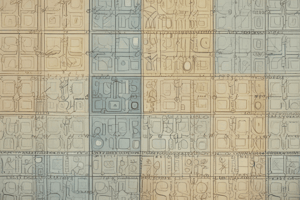Podcast
Questions and Answers
Which generation first reveals the recessive trait associated with white flower color?
Which generation first reveals the recessive trait associated with white flower color?
- F2-Generation (correct)
- F1-Generation
- P-Generation
- None of the above
What does Mendel’s Principle of Segregation of Alleles explain?
What does Mendel’s Principle of Segregation of Alleles explain?
- The ability of alleles to blend in hybrid phenotypes
- The combination of alleles from both parents
- The permanent change in allele frequency over generations
- The random separation of dominant and recessive alleles during gamete formation (correct)
How many total chromosomes do humans have?
How many total chromosomes do humans have?
- 46 chromosomes
- 44 pairs
- 23 pairs (correct)
- 22 pairs and 1 Y chromosome
Which of the following correctly describes phenotypes in Mendel's work?
Which of the following correctly describes phenotypes in Mendel's work?
What role do chromosome pairs play in heredity?
What role do chromosome pairs play in heredity?
Study Notes
Mendel's Principles of Inheritance
- Mendel's Principle of Uniformity states that when two pure-breeding parents with contrasting traits are crossed, their offspring (F1 generation) will all express the dominant trait.
- Mendel's Principle of Segregation of Alleles states that during gamete formation, each pair of alleles separates, so that each gamete receives only one allele from each pair.
- Characters, which are the observable traits of an organism, are determined by genetic characteristics, called alleles, which exist in alternate forms.
- The phenotype, or physical expression of a trait, is determined by the dominant allele.
- Alleles segregate randomly during gamete formation, meaning that each gamete receives one allele from each pair, with equal probability.
- The P-generation represents the parental generation, where one parent carries the dominant allele for red flower color and the other carries the recessive allele for white flower color.
- The F1-generation is the first filial generation, resulting from the cross between the parental generation, displaying hybrid phenotypes.
- The F2-generation is the second filial generation, produced from the self-fertilization of the F1 generation, where the recessive trait reappears in individuals that are homozygous for the recessive allele.
Human Chromosomes
- Humans inherit 23 pairs of chromosomes, one set from each parent.
- Each chromosome carries multiple genes, which are segments of DNA.
- The genetic code of DNA is composed of four nucleotides: Adenine (A), Thymine (T), Guanine (G), and Cytosine (C), arranged in specific sequences.
- Chromosomes are visualized and numbered from 1 to 22, with an additional Y chromosome for males.
Studying That Suits You
Use AI to generate personalized quizzes and flashcards to suit your learning preferences.
Related Documents
Description
Explore the foundational concepts of genetics as established by Gregor Mendel. This quiz covers principles like uniformity, segregation of alleles, and the relationship between genotypes and phenotypes. Test your knowledge on how traits are passed from one generation to the next.





